#Thai Japan iconic Music Festival
Text
August 3, 2018: As the Sun Sets - In Banpo
Golden hour is over; we threw our caps in the air during the evening of graduation; now we were watching our final sunsets in Banpo Hangang Park.
Night is falling and our time in Seoul is ending.
안녕하세요,
Friday, August 3, 2018: Water hell!
I was supposed to go do a tour around the Blue House (청와대/Cheong Wa Dae), the official residence of South Korea's president, Moon Jaein, at 2 PM. We were supposed to meet in front of Gyeongbokgung Palace at 1:30, and my plan was to go earlier and tour around the palace, since it's already been six weeks, yet I still needed to visit the most popular tourist spot in Seoul.
I woke up at 11 AM, just in time for Davy's Cheong Wa Dae tour to start, and checked my phone to see how hot it was.
"Feels like 114 degrees".
Well, that was the end of my day. I suppose I could always visit the palace on my next visit in Seoul. If it survived thousands of years, I was certain it will survive just a few years more.
My phone lit up with messages from Kakao Talk.

Our Naengmyeon Homies group chat was living up to its name. Valentino wanted to leave at 11:45 AM as he was still finishing his draft to send to the KUISC director in regards to Minki-hyung (민기형) not getting his certificate for participating in the buddy program. They said that since he missed the Boryeong Mud Festival (he told them he was sick, but we know he went to the booze cruise with us), he lost participation points, therefore rendering him unable to receive a certificate. Of course Minki-hyung (민기형) was very upset, so as a group, we started sending the KUISC director emails proving why Minki-hyung (민기형) deserved that certificate and the Best Buddy award that was given during graduation.
Even though Minki-hyung (민기형) didn't win Best Buddy award, the whole auditorium knew how popular and special he is to our group since we were the only ones to cheer for him every time his face showed up on the KUISC highlights video.
Valentino said Cara woke up vomiting but was still willing to get bibim-naengmyeon with us; so, we met up in front of Frontier House and went to the usual naengmyeon place, just by the cheap kimbap restaurant.
During our naengmyeon meal, Cara nonchalantly grabbed the mini trash bin on our table and vomited. Only I and a Korean lady next to us noticed her vomiting. Valentino, who was sitting next to Cara, looked over the table next to her to see the Korean motioning him to check on Cara with her eyes.
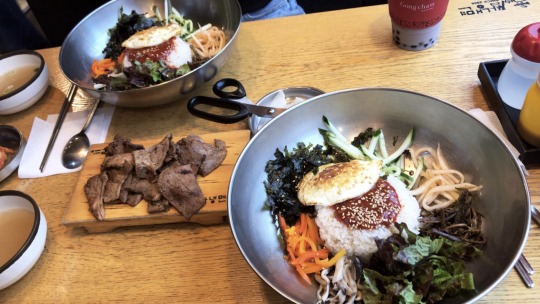
After the meal, we decided to mix our credit cards on the table and pick one card to pay the bill with, and I didn't realized I whipped out my Frontier key card; Cara also did the same, but after we left the restaurant, she noticed that she forgot her Frontier key card on the table and she pushed me to ask if they have it on the counter, which they did.
Water hell! Did I just have a déjà vu moment?
On the way back to Frontier, we talked about how much we would miss Sulbing and authentic bingsu in Seoul, so we stopped by Anouk, a bingsu place just next to the Frontier stairs. We got the God of Bingsu for ₩18,000 with green tea, black choco, and red cherry flavors.
While waiting for our bingsu, we started creating memes from last night's drinking videos, such as Joyce saying "water hell" really fast.
We would make terrible memes incorporating "water" and "hell" together so much that Hyungki-hyung (형기형) asked the group chat:
Hyungki-hyung (형기형): wth is water hell
In which Cara corrected him with "water hell is water hell"
Our table erupted in laughter.
Matt also took a picture of the sign in Anouk directing where to get water and attached the word "hell" by it, and also posted a link to an apparent email he sent to the KUISC director in the group chat, just for it to be redirected in a never ending page of "water hell" repeated over and over.
Water hell, right?

We went back to our dorms and I sat on the lounge in the third floor just to cool off and I started realizing how empty it was becoming. It used to be loud and busy, with Ben's music playing in one end of the floor and guys singing across the other end.
Naengmyeon and bingsu left me tired, so I slept through the rest of the afternoon.
I woke up at 7 PM to the group chat in Banpo Hangang Park for the Dokkaebi Night Market (도깨비야시장). We've been talking about going to Dokkaebi Night Market since we saw the posters in Line 6 during the first weeks in KUISC yet nobody had decided when and where to go, since the night market was every weekend in four places: Dongdaemun Design Plaza, Cheonggyecheon Stream (Mojeongyo Bridge-Gwangtonggyo Bridge), Yeouido Hangang Park, and Banpo Hangang Park.
I wanted to go to Yeouido Hangang Park since it's the biggest out of the four and I haven't been to the park and took a picture with the "I Seoul You" sign; but Minki-hyung (민기형) insisted we go to Banpo Hangang Park because he's never been there and it's still as lively even though there's less people than Yeouido Hangang Park. This was going to be our last hangout in Seoul together.
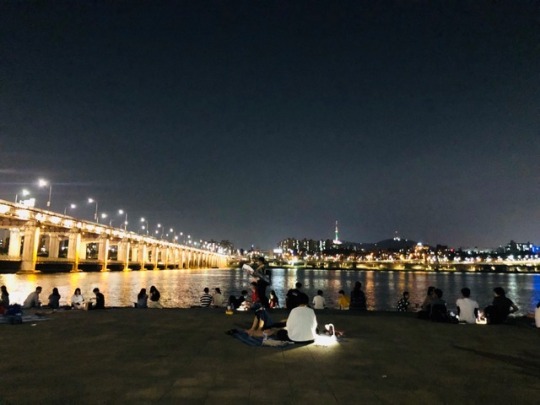
I arrived at Banpo Hangang Park at 9 PM and bought pork tteokbokki and earl gray chocolate latte at Oppa truck with Carolina before heading to the center of the park just next to the Banpo Bridge with her, Matt, Florence, Minki-hyung (민기형), Jordan, Harley, Peter, Darren, Cindy, Angela, Lina, Maite, and Davy. Angela's roommate was kind enough to let us borrow a picnic blanket, so we sat down and played music with Matt's speaker.
Of course, since iKON just released their mini album Continue the day before, I blasted "죽겠다 (Killing Me)" during the night.
After being six weeks in Seoul, I never had the chance to try dakgangjeong (닭강정/sweet and spicy chicken), so I went back to buy a sweet dakgangjeong (닭강정) at Double 8.
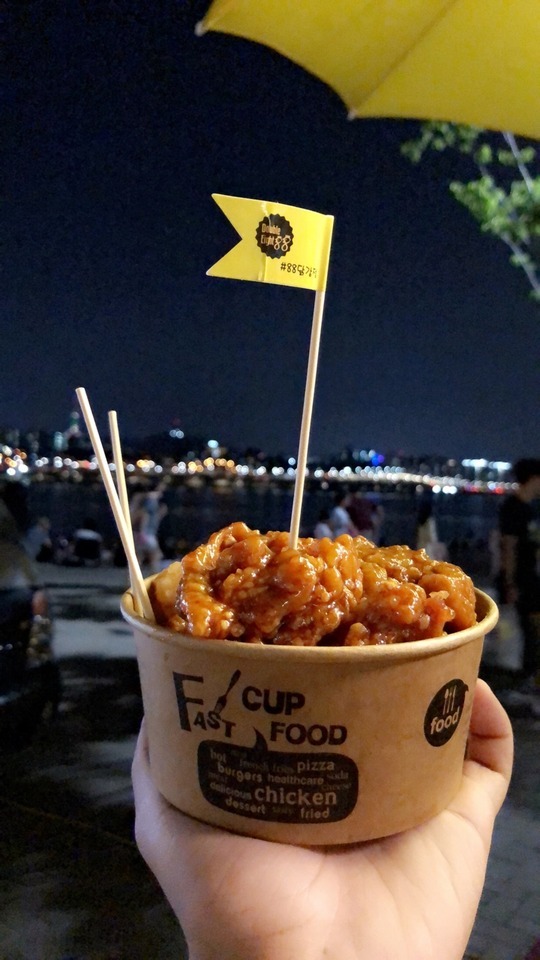
Wendelyn joined us after; Valentino and Cara wanted to join with us too, but being too far from Frontier made them not want to go and asked us to meet with us around Anam later instead.
Darren, Angela, Cindy, Harley, Jordan and I went to the opposite side of the bridge to Sebitseom (세빛섬), which are artificial islands with different centers and buildings, such as for arcade games, performing arts, etc.
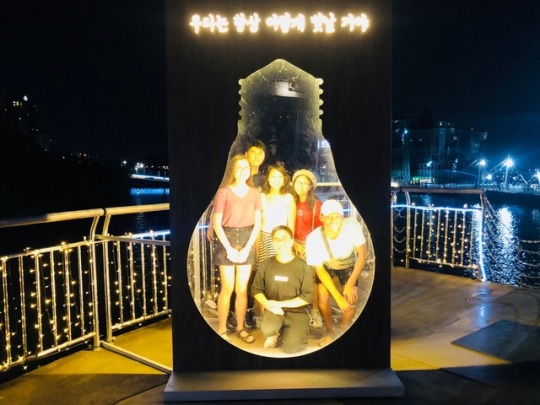
We took the bus and subway going home, where Davy taught me and Lina some tricks to work the Rubik's cube, although we both did not pick up any new knowledge.
Erin messaged us that she was giving away her remaining 10+ SF9's Sensuous albums from when she bought 40 albums to try and get a fan sign pass to meet the boy group.
When we reached Anam, everybody dispersed but Wendelyn, Florence, Matt, and I headed to McDonald's to meet with Valentino and Cara. Peter volunteered to pick up the box of SF9 albums at CJ International from Erin and kept it in his room until I picked it up later that night. We stopped by the arcade place where Wendelyn was trying to win a white bear plush. There was a guy next to us on the Pokémon claw machine trying to get bulbasaur, which was on the verge of falling. He left to get his money changed and I tried my luck to get the Pokémon plush - which I did.
My first ever claw machine win.

Matt had to drag us out of the arcade place because we were so close to spending a lot of money to get Wendelyn her white bear.
At McDonald's, I had Valentino sign my taegukgi (태극기) since he was leaving in the morning to reunite with his family in Seoul, before leaving for Japan.

They all headed straight to a noraebang (노래방), but I wasn't worried about not going because I would still see them the next day. I went back to my dorm to start packing and picked up the SF9 box from Peter, which included a Blackpink poster and BAP's Ego album. Thanks Erin!
Sophie wanted one copy of the album for each version, while Valentino, Matt, and Cara each wanted one for their own. Carolina asked to keep the remaining albums so she could mail them back home in Brazil.
I finished packing my main luggage within minutes, just for me to finally realize that I needed to buy another one. I was so terrified that I might be charged excess because the main luggage only had souvenirs and extra materials I collected and bought from all the way in Hong Kong two months ago. I really needed to get an extra bag to fit in my clothes.

It was barely 2 AM and everybody was still at the noraebang (노래방) and Lina wanted to meet up with me in front of Frontier so we could head to meet with the group together; but first, she needed to pick up a few things from Maite at the Global House. Maite was leaving in the morning and gave us a Don Q Pasion Puerto Rican rum since she couldn't take it back with her to Puerto Rico.
Sophie. Thai. Jon. Maite. Four gone, more to go.
Lina needed to stack up on the cheap cigarettes in Seoul for her to take home to Singapore, in which she bought a total of 21 packs from two convenience stores. The poor guys working probably had so much questions by the way their eyes reacted when Lina told them to give her 21 packs with her basic Korean skills.
Her biggest worry is getting them through the Singaporean customs since the country places a very expensive tax on cigarettes.

So, Lina and I were on our way to the noraebang (노래방), when we bumped into Darren, who was headed home and invited him to join us.
"I can't. Maybe next time?" he said.
"There will never be a next time," Lina responded. That phrase hit me how close we are to perhaps never seeing each other again.
That was the last time I would ever see Darren.
At the noraebang (노래방), Matt and Cara were screaming love songs, while rocking their head back and forth as if they were hosting a screamo concert. Wendelyn, Valentino, Asra, Salli, Joyce, Florence, and Peter were sitting around Matt and Cara, while drinking soju bottles and Maite's Puerto Rican rum. Salli was so excited to pour everyone a cup of the rum, since, as another Puerto Rican, it was her favorite alcoholic drink.
We all knew that it was going to our last noraebang (노래방) session together, so when we ended our final one with the most iconic song of the last six weeks.
김범수의 "보고 싶다"/Kim Beomsu's "Bogo Shipda/I Miss You".
Matt, Tino, Cara, and Peter hailed a taxi cab to take them back to Frontier House since they were feeling lazy walking back up the Frontier stairs (and the taxi cab was only ₩3,000), while Lina and I walked on the way back. She picked up extra cardboard boxes so she could place her excess luggage in it and ask Florence to mail them to her home in Singapore.
It was four in the morning on Saturday, August 4. I was leaving South Korea the next day.
When I returned to my dorm, Matt messaged us a copy of the email he sent to the KUISC director regarding Minki-hyung (민기형)'s buddy certificate, which showcased how much he went above and beyond his responsibilities to make sure we had the best six weeks to the point that he wasn't even our buddy anymore. He was our friend who had partaken in every single adventure with us in KUISC and outside the program.
Minki-hyung (민기형) welcomed all of us (group 3 or not) into the circle and we really appreciate him immensely.
The group chat became emotional and started reminiscing the funny memories we had created with Minki-hyung (민기형) in the last six weeks. We really hope to reunite with him one day, but until then!
고마워요,
Chris 「크리스」
P.S. The homecoming event for the students who just came back from studying abroad is tomorrow, so I hope to use that event as a means to relive the good times and as a reminder to never forget everyone's contribution to making this year's summer worthwhile.
P.P.S. I hope to finish writing and post the fourth and final blog of the "As the Sun Sets" series, which is the last blog of my entire study abroad adventures within the next few days. I plan to follow up with a few blogs on the homecoming event and some informational blogs regarding the study abroad program.

1 note
·
View note
Text
A Glossary Of Terms
1-kyu:
First level. As in the top level of the Japanese Language Profiency Test!
A man:
Ten thousand. Sounds cool, don't it?
Anime:
Cartoon.
Apato:
Apartment.
Apato Biru:
Apartment building.
Apropos:
Appropriate (French).
Arubaito:
Part-time job, esp. one for students.
Asa-gohan:
Breakfast (lit. "morning rice").
Base brat:
Someone whose parent(s) was (were) military personnel, therefore necessitating living on military bases and multiple traumatic cross-country moves during childhood.
Bento:
Japanese boxed lunch.
Bit:
Slang for stole, copied, and/or plagerized..
Blocking:
A stage term that means where actors are supposed to stand on-stage.
BOE:
JET abbreviation for Board Of Education.
Boshi:
A hat or baseball cap.
Bosozoku:
Young Japanese gang members who ride around on real noisy, super-modified motorcycles (lit. "speed tribes").
Bougie:
Slang term for "bourgeois"
Bunkasai:
School "culture festival;" a bizarre mix of talent show, open house and carnival.
Bureki:
Brakes.
Can't Be Arsed:
See "couldn't be arsed."
Carte blanche:
The freedom to do whatever you please (French).
-Chan:
Attached to someone's name to infer affection for that person as a friend. Also used to indicate that the person being refered to is a child.
Chelsea Smile:
Inserting a knife into the mouth of a person one is assaulting and cutting at either end of the mouth, so as to extend the victim's smile in a grotesque fashion.
Chikan:
Pevert or molester. See also hentai
Chimpira:
A low-level yakuza.
Chi chi fou fou:
Fancy.
Cho:
Very. See also totemo.
Chotto:
A little.
Chugakko:
Junior high school.
Chugakkusei:
Junior high school student.
Conbini:
Convenience store (Montréalers: depanneur), which are ubiquotous in Japan.
Couldn't Be Arsed:
English slang, meaning "couldn't be bothered." Also works as "can't be arsed."
Crust:
A style of punk rock known for its death metal-esque vocals and overall severity. Crust punks are well known for their aversion to personal hygeine and love of mescaline.
Dafuya:
A ticket scalper.
Daibutsu:
Buddah. Or, more commonly, a giant-ass statue of the Buddah.
Daigakko:
University.
Daikyuu:
A day off in lieu of having worked on a regular day off (e.g. do-yobi).
Dame, dame:
Forbidden, as in "don't do that!"
(da)Saitama:
A nickname for Saitama City used by the more cosmopolitan Tokyoites. Dasai means "uncool."
Deets:
Slang term for "details."
Denki:
Electricity; or, electronics store.
Depato:
Department store.
Deshita:
Was. Kind of.
Dinkus:
Dink (Latin).
DIY:
"Do It Yourself." A punk rock manifesto/slogan (North America) or the way to describe homeowner-done home renovations (Merry Olde England).
Dodgu baru:
Dodge ball (formerly known as murder ball).
Dojo:
A school or building devoted to martial arts.
Domo arigato gozaimashita:
"Thank you very much."
Dorama:
Katakanasized English for "drama," meaning "soap opera."
Dosh:
Money. Sorry, I've been renting to many "there's gangsters in London"-type movies lately!
Do-yobi:
Would be Saturday, wouldn't it now?
Echo Parque:
Echo Park. A neighbourhood in Los Angeles (Spanish).
Eigo:
English.
Eikawa:
English conversation school.
El Jefe:
The boss (Spanish).
Enkai:
The legendary "office party" of Japan, where you colleagues try to get you as drunk as possible. Notorious for being the social occassion where the reserved and meek Japanese people you work with go off and get nuts.
Ethiopia no ryoori:
Ethiopian food. Look, just put any country before no ryoori and you are talking about the food of that country. It's just that easy!
FA:
Fuck All
Fameru, the:
The other, more centrally-located but crappier, apartment building wherein almost all the other AET's working for the Saitama-shi are housed.
Flossing:
Wearing clothing or jewelry in a flashy, homologic manner.
Flush:
In the wacky world of poker, five cards of the same suit. A good hand.
Furikomi:
Transferring money from your bank account to someone else's.
Fushigi:
Weird, as in spooky or mysterious weird. Like an Astro-boy action figure spookily and mysteriously "floating" in a Denny's toy. Hello? Go back and read the sentence again!
Gaijin:
Foreigner. Non-Japanese.
Gaijin cado:
The "Alien Registration Card" that every foreigner living here is required to carry at all times.
Gaikokku:
Foreign country or countries. Any country or countries that is not Japan.
Gakusei:
Student. Or students. Depending.
Game senta:
Arcade ("game centre" - get it?).
Ganbaranai!:
"Don't try!" "Why bother?" "Do a half-assed job, if even that much." The opposite of ganbatte.
Ganbatte yo!:
"Fight!" "Try hard!" "Do your best!" J-folk never tire of uttering these words of encouragement at every opportunity.
Genkan:
That part of a J-house right after the front door where you take off your shoes. Considered part of "outside," so if you don't leave your door locked here, don't be surprised when delivery guys, Jehovah's Witnesses, the cops and the NHK guy just open your front door and stand in the genkan, calling for you!
Genki:
Healthy, happy, in good spirits, socialable, frisky. Pick one or a combination thereof.
Genkikunai:
Unhealthy, unhappy, in poor spirits, unsocialable, not frisky. Pick one or a combination thereof.
Geri:
Either diarrhea or having sex with your girlfriend. Can't remember which one, but either way, geri is a top-notch excuse to give your supervisor when you want the day off. Though I'd recommend seiri-tsuu for the ladies.
Getsu-yobi:
Monday. You didn't read the week one entry very closely, did you?
Gi:
Martial arts uniform. Costume? Get-up? No, uniform!
Giving us the hi-hat:
1920's gangster slang for being snubbed or disrespected, see?
Glasgow Kiss:
A head butt.
Gobsmacked:
Flabbergasted; astounded; shocked (English slang).
Gomen nasai:
"I'm sorry."
Haafu:
Katakanized English for "half," which is how mixed-"race" offspring of one Japanese parent & one gaijin are actually refered to here!
Hanabi:
Fireworks.
Hanamizu:
Snot (lit. "nose water").
Hanko:
A stamp or personal seal, used in lieu of a signature on most legal documents, bank forms, etc.
Hansomu:
Jinglish for "handsome."
Harajuku:
A popular district of central Tokyo, known for attracting throngs of young people dressed to nines in all manner of garb. Particulary on Sundays!
Hawdkoah:
The New York City pronounciation of "hardcore", a style of punk music.
Hella:
San Francisco slang for "very" (lit. "hell of").
Hentai:
Pervert. See also chikan.
Hiragana:
One of the Japanese syllabic alphabets.
Hisashiburi ne!:
"Long time, no see!"
Ichi-nensei:
First-year students (Canadian translation: 7th grade).
Inaka:
The country. A rural area.
Isofuckingashii:
Bufuckingsy.
Itabashi-sensei:
My supervisor at the Saitama Board of Education.
Itai:
"That hurts!" lit."ouch!"
Italian run-through:
When an actor, in rehearsal, goes through their lines as quickly as possible. Used to assist with line memorization
Itari no ryoori:
Italian food.
Izakaya:
Japanese-style drinking/eating bars designed to accomodate larger groups of drunks.
Janken:
Rock, Paper, Scissors.
JET:
The Japan Exchange Teaching program - how I managed to fanagle my way into this country.
Jet Coaster:
Roller coaster.
Jido hanbaiki:
Vending machine.
Jiko shokai:
A self-introduction - a prepared speech used to introduce yourself to others.
Jitensha:
A bicycle.
Joie de vivre:
"Joy of life." (French)
Jozu:
Skilled, talented, impressive.
Jofuckingzu:
Skilfuckingled, talenfuckingted, imfuckingpressive.
JTE:
JET program jargon for a Japanese Teacher of English.
Judo:
A Japanese martial art involving the throwing of people. Derived from ju jitsu, another Japanese martial art.
Juku:
Lit. "cram school." Private tutoring-style schools most kids go to after regular school, to give them that edge on the all-important, life-determining exams they face at the end of junior and senior high school.
Ju-ni-nichi matsuri:
Some sort of weird festival in Urawa that appears to celebrate December 12th. Literally translates to "The Festival of the 12th."
Kafucho:
Hay fever. But really, pollen allergy, esp. cedar pollen allergy. Which is bad news given that 60% of Japan's forests were clearcut to make way for cedar plantations.
Kai-yobi:
Tuesday. You didn't read the week one entry very closely, did you?
Kame:
Turtle.
Kana:
The Japanese written language, composed of the hiragana, katakana and kanji alphabets.
Kanji:
The Japanese characters that are actually Chinese characters and usually have two or three totally unrelated pronunciations and meanings. Oh, and there are thousands upon thousands of them, too.
Kanpai:
Cheers/Skoal/Here's Mud In Yer Eye.
Kare rice:
As near as I can figure out the Japanese pronounciation for "curry rice," a popular Japanized curry dish.
Kasa:
Umbrella.
Katakana:
The Japanese syllabic alphabet reserved for non-Japanese words.
Katana:
Those cool samurai swords. Also, an iconic "rice rocket" made by Kawasaki.
Kawaii:
Cute.
Keitai:
A cellular telephone. Which you would have ascertained, had you continued reading the sentence.
Kendo:
A Japanese martial art involving wooden swords and the hitting of people with them.
Kenkyujo:
The proper pronounciation of the Japanese word for Research centre. Specifically, the Saitama City BOE research centre.(see also kinkyujo).
Kimpura:
Um, marinated shredded vegetables? Not entirely sure, but I eat it!
Kin Jeh:
Vegetarian. Though I cain't recall if it means "vegetarian food" or "vegetarian person." Ask Thi. She'll know. (Thai).
Kinkyujo:
Research centre. Specifically, the Saitama City BOE research centre.
Kin-yobi:
Come on. If moku-yobi was Thursday and this followed Thursday, what the hell day do you think it is?
Kissaten:
Café/coffee shop.
Koban:
Police box - a little, mini-office where at least one cop is always present. Thousands of thems all over Japanese neighbourhoods, which is sometimes credited as a reason for Japan's low crime rate.
Kocho-sensei:
Principal (lit. "head teacher").
Koguro:
aka "ko-gals." Lit. translating to "high school girls," this refers to a Japanese female youth subculture where teenage girls bleach their hair, tan themselves as dark as possible, wear a lot of white makeup and dress as cute as possible. Think Britany Spears as done by David Lynch and you are getting close to what it's like.
Kokkoi:
Cool.
Konnichiwa:
Hello/Good day.
Konshu:
This week.
Kowe:
Scary (refering to males).
Kowaii:
Scary.
Kuro:
Black.
Kyoto-sensei:
Vice-Principal.
Kyudo:
Japanese archery.
Kyuryobi:
Payday.
Lactards:
The lactose intolerant; usually those whose bodies do not produce the enzyme required to digest the protein lactose, found in milk and diary products.
La Comida Mexicana:
Mexican food (Spanish).
Live House:
A bar where bands play. The tweaked thing is that, unless the band is huuuge, they probably have to rent out the venue, PA & staff and produce the show themselves. Cost? 300,000 - 400,000 yen! Yipes!
Maddog:
To glare at someone in as threatening a manner as possible.
Maka:
The accepted abbreviation of Makadonorado.
Makadonorado:
McDonald's - an American fast-food restaurant chain, popular in Japan. See also Maka.
Mamachari:
A "shopping bike" - a rickety old-style bike with a basket on the front and sometimes the back. The kind you'd expect to see grandmas trucking around on. Which they do. Along with everyone else.
Man:
10,000.
Manga:
A Japanese comic book, which are read by children and adults alike and cover every possible topic and story, including golf, tennis and, of course, pornography.
Mansion:
Hilariously enough, what they call really big multimulti unit apartment buildings!
Matsuri:
Festival.
Megane:
Eyeglasses.
Meishi:
Business card (lit. "name card").
Melonpan:
A melon-flavoured bun. Also, a character on the popular children's television series Ampanman. Whose title character is a flying superhero with a sweet bean-paste-filled bun for a head.
Merde:
"Shit," in French.
Mi Vida Loca:
"My Crazy Life." In this case, a pretty good gang film. Not the Ricky Martin song (Spanish).
Moku-yobi:
Come now, you deduced that this was Thursday all by yourself, didn't you?
Moleto:
Wallet (Spanish). Possibly the only spanish word I remember from that summer class I took four years ago.
Mugly:
Weather so hot and humid ("muggy") that it is downright ugly ("ugly"). Just because I made a word up does not mean that it should not be in everyone's lexicon.
Muzukashii:
Difficult.
Nasi goreng:
Thee scrumptious, rice-based national dish of Indonesia.
Natsukashii:
Kind of when something caused you to reminisce in a happy, sentimental, "ah, the memories!" way.
Ne?:
"Isn't it so?/Don't you think?" Liberally inserted at the end of practically any sentence. Similar to the Canadian "Eh?" Or the Parisian "quoi?" Or the Québecois "la." Etc.
Neko:
Cat.
Nenkyu:
Paid vacation time. Which, in theory and according to your JET contract, you can book off with your supervisor without much problem. In theory.
Nihon-go:
Japanese language.
Nihon-go no sensei:
Japanese language teacher.
Nihon-jin:
A Japanese person.
Nihon ryoori:
Japanese food.
Niku nashi onegai dekimasu ka:
Could you pretty please make that without putting dead animal parts on it?
Ni-nensei:
Second-year students (Canadian translation: 8th grade.
Nissei:
Second-generation Japanese living somewhere other than Japan.
Nomihodai:
A special and popular deal at Japanese bars, where you and your friends may drink all you possibly can in a set period of time, for a set price.
Nova usagi-chan:
The annoying animated rabbit mascot of the largest chain of private English schools in Japan, whose theme song is permanently ingraved on my memory thanks to heavy airplay of their TV commericals. "Ippai kikite, ippai shaberuru NOVANOVA!".
Off-book:
A stage term meaning that an actor has memorized their part and can or will rehearse without having to look at the script.
Ohayo gozaimasu:
Good morning.
Ogenki desu ka?:
How are you? (honorific form).
Oishii:
Delicious.
Ojiisan:
Grandfather. But let's not start singing about his stupid fucking clock, ok?
OLs:
"Office Ladies." Women working low-level secretarial/receptionist/clerk positions in Japanese offices, until they get married and stop all this silly nonsense about having a career. Which means pretty much any woman working in an office in Japan, since, of course, only men should be promoted or hold positions of importance or responsibility.
Omiyage:
Little individually-wrapped snacks you bring back from a trip to anywhere for all your co-workers. A major Japanese tradition.
Onigirii:
Popular J-snack of a triangle of rice wrapped in seaweed, usually with a fishy or seaweedy centre.
Onsen:
Hot spring. J-folk loooove love love to visit the innumerable hot springs dotted around Japan on their vacations.
Onis:
Demons.
Otaku:
Nerds. But especially obsessive-compulsive collecting nerds.
Pachinko:
This wildly-popular but weird gambling game involving a sort of vertically-mounted pinball machine, hundreds of steel balls, prizes and a lot of noise and flashiness.
Pit justice:
A straight-edge slang term for physically attacking someone in the dance area of a punk rock concert.
Player:
One who maintains a high level of romantic popularity and multiple romantic relationships.
Poutine:
French I mean Freedom Fries smothered in a special gravy and then covered with melting cheese curds. Québec's national dish, right above chien chaud steamée.
Purikura:
Special arcades specializing in those cute photo sticker booths where you take pictures with your friends and then customize them like mad.
Quelle Surprise:
"What a surprise!" (French).
Queue:
A line of people. (British).
Queuing:
Lining up (British).
Restos:
A Montréal abbreviation for "restaurants" (probably French).
Reverse:
Puke (verb).
Roku-nensei:
6th graders.
Romanji:
What they call the Roman (read: English-language) alphabet o'er here.
Ryokan:
A traditional-style Japanese inn.
SaiSta:
Slang for former World Cup venue Saitama Stadium.
Saisho RU! Janken PON!:
What J-people say instead of "1,2, 3!" when playing Janken. (see Janken).
Saitama BOE:
The Saitama City Board of Education.
Saitama-ken:
The prefecture of Saitama. A prefecture is like a province or state. 47 of 'em in Japan!
Salary(wo)man:
Business(wo)man. But pretty much always men. Women who work in offices are OLs.
San-nensei:
Third-year students (Canadian translation: 9th grade.
Seiri-tsuu:
Menstrual cramps.
Sempai:
The more senior, and therefore, superior person in a given work/school situation.
Sensei:
The honorific term for teacher.
Senta Gyaru:
Katakaniz'd English for "Centre Girl," which refers to a mostly-female subculture of high school girls who hang around Shibuya's Centre Street dresses in animal costumes with their hair dyed as unnaturally fluorescent as possible, with fake jewels glued on their faces. See also koguro.
Senta Guy:
The male version of a senta gyaru.
Seppuku:
Japanese ritual suicide.
Servo:
Brain (French).
Shag:
Fuck (British slang).
Shanked:
To be stabbed with a homemade or improvised knife.
Shibuya:
A popular district in central Tokyo for shopping, food, or dates. I like to pronounce it "shi- BOO-YA!" but somehow I don't think that's very original of me. Satisfying, though!
Shinjuku:
A popular district in central Tokyo, known for its nightlife.
Shinkansen:
Tha bullet train! Pow! Zip!
Shippu:
Stinky ointment-laced gauze. Did you not read the sentence or something?
Shizzy:
Slang term for shiznit, which is, in itself, a slang term.
Shiznit:
The stuff, the deal, etc.
Shogakko:
Elementary school.
Shogakkusei:
Elementary school students. I mean, in only follows, right?
Shogunai:
"It can't be helped." The J-way of saying, "sorry, you're fucked!"
Shogunakatta:
Past tense of shogunai.
Shojin ryoori:
Lit. "temple food." Special Japanese vegetarian you'll find at Buddhist temples, emphasizing elements of Buddhism in food form.
Shoppingu:
Shopping.
Shoppu:
Shop. See, it's not so hard, hey?
Shouganai:
It can't be helped/there's nothing to be done about the situation.
SIKE!:
1980's slang for "I tricked you!", yelled at the tricked in a mocking tone.
Skint:
British slang for flat-ass broke.
Slowplayed:
To have played a strong hand weakly, by checking instead of betting or by calling instead of raising. Usually done to win extra bets by keeping more players around for future rounds of betting. Thank you U of A type Jonathan Schaeffer for the definition!
Somen:
A type of Japanese noodle, usually served in a tasty soup.
Souji:
Cleaning/cleaning time.
-Sugoi:
Great.
Sui-yobi:
Wednesday. You should be getting the hang of the yobis now, right?
Sumimasen:
Excuse me/pardon me/sorry 'bout that. One of the handiest and most oft-used expressions in The Japan. Learn it, live it, love it.
Sumo:
You know, those really big fat Japanese guys that wrestle each other? Like in that Weezer video!
Support:
What English people call the opening act.
Tabernac:
The short version of tabernacle, which is essentially the French equivalent of "fuck."
Tacoyaki:
A super-popular Japanese streetfood, consisting of chopped octopus cooked in little balls of batter, served with tons of mayo and dried fish flakes. Taco=octopus, which can be a bit of a surprise if you are trying to order la comida Mexicana.
Taiko:
Japanese drums/drumming.
Taikukan:
Gym.
Takyuubin:
Delivery/courier company.
Tarento:
"Talent" - minor celebrities and personalities that populate the game/talk shows that comprise 90% of Japanese television.
Tatami:
Rice-straw mats that serve as flooring in traditional Japanese rooms. Most houses have at least one tatami room and rooms in Japan are measured according to how many tatami mats they fit or would fit.
Terebi:
Television.
Terebi dorama
TV drama.
'The Bash:
Our nickname for Itabashi-sensei.
The filth:
English slang for police.
The Old Bill:
Slightly-more polite English slang for police.
The River:
The last card dealt in a hand of poker. What Mile End Poker Society members would term "fifth street."
Tomodachi:
Friend.
Tori:
Chicken.
Totemo:
Very. See also cho.
Toyu:
Kerosene.
Tweaker:
Amerian west coast slang for person addicted to methamphetamine, aka speed.
Udon:
A broad noodle.
Unko:
Shit.
Urusai:
Shut up (lit. "[too] noisy/loud!").
Usagi:
Rabbit.
Utage:
I honestly have no fucking idea what "utage" means. Can anyone help me out here? Good fucking alcohol, though. Real tasty, that there utagehol.
Vick:
Victimize.
Vignette:
A short scene (French).
Wa, The:
Harmony. Balance.
Wakarimasen:
"I don't understand." See also wakarinai.
Wakarimashita:
To understand, past tense, formal.
Wakarinai:
The less polite, informal version of "I don't understand." See also wakarimasen.
Wakaru:
The unconjugated form of "to understand."
Wakatta:
The shortened, informal, past tense form of "to understand."
White Day:
A special, Japanese-only holiday invented so that Japanese men could buy Japanese women white gifts and/or chocolate, partially to reciprocate them for having received gifts and/or chocolate on Valentine's Day. Which, in Japan, is when only men receive gifts from women, never vice versa.
WTF:
What The Fuck.
Yakisoba:
Fried noodles, usually with pork or beef and some other stuff.
Yakitori:
Grilled pieces of chicken on a skewer.
Yak:
See yakuza.
Yakuza:
Every country has their own version of the mafia. The Yakuza are Japan's.
Yamasigawa-sensei:
My supervisor's assistant at the Saitama Board of Education.
Yorushiko onegaishimasu:
Sort of a catch-all polite phrase to use when asking someone to do something for you.
Yubinkyoku:
Post office.
Yukatta:
Traditional Japanese summer garment, similiar to a kimono but made of lighter cotton instead of silk. Still just as difficult to put on, though. Or so I'm told.
Yuki:
Snow.
Yuki Matsuri:
Thee Hokkaido Snow Festival. One of the biggest and most famous festivals in Japan. Kind of like the Québec Winter Carnival, but with more snow sculptures and less Bon Homme.
1 note
·
View note
Text

The Philippines is often overlooked by foreign travellers in favour of other Asian destinations, but there’s no better time to get to know this tropical archipelago.
With 7461* islands (at low tide!) and a feast of screensaver-perfect backdrops – from dreamy tropical beaches and smouldering volcanoes to mesmerising rice terraces and crumbling Spanish relics – the Philippines is one of south-east Asia’s most exotic getaways.
(*Yes, according to the National Mapping and Resource Information Authority (NAMRIA), following a report from the Philippine Islands Measurement Project, the number of islands recognized as Philippine property is actually larger than the 7,107 islands people were taught in school for decades. Some had just been missed due to a lack of technology, and others are relatively new islands that are the result of changing landforms.)
Yet to many travellers, this lush archipelago – anchored between the South China Sea and Pacific Ocean – remains an under-appreciated mystery; usually ignored in favour of its near-neighbours Thailand, Vietnam, Malaysia and Indonesia (Bali), despite the efforts of Filipino tourism chiefs, whose slogan, “It’s More Fun in the Philippines”, and the new ad with world-famous travel blogger, Jack Ellis, “When you’re with Filipinos, you’re with family” graces billboards everywhere.
Palawan
So why take a punt on the Philippines? Aside from the fact that low-cost Filipino carrier Cebu Airlines has launched flights between the Philippines and other international destinations, taking on the national carrier Philippine Airlines, and the fact that you’re dealing with bargain, Bali-esque prices, what is there that appeals here?
How about gorgeous landscapes, a spellbinding cast of wildlife (both on land and under water), exuberant festivals, romantic hideaways and thrilling adventures, sumptuous seafood and rum-fuelled parties and the chance to mingle with some of the cheeriest people on earth.
And you’ll have no worries communicating with them. Alongside Tagalog (Filipino), English is the Philippines’ unofficial language (a legacy of the country’s strong American influence).
Compiling a maiden Filipino travel itinerary can be tricky (did I mention there were 7461 islands?).
So here are some ideas to get you started.
MANIC MANILA
Most travellers fly into Metro Manila, which, with its Bangkok-style traffic jams and its glaring chasms between the ostentatiously rich and the heart-wrenchingly poor, provides an in-your-face introduction to the Philippines. However, the Filipino capital is an absorbing and enthralling place to explore.
To familiarise yourself, join a walking tour with Carlos Celdran, an acclaimed guide who uses street theatre to trace Manila’s topsy-turvy history. His signature tour covers Intramuros – the photogenic, and fairly placid, old walled quarter founded by the Spanish colonialists in the early 16th century. (celdrantours.blogspot.com)
It was partially rebuilt after being flattened during World War II when the US and Japan fought for control of the city, then known as the pearl of the Orient. Another Celdran tour (Livin’ La Vida Imelda) explores the controversial life of Imelda Marcos, the shoe-loving wife of former President, Ferdinand Marcos. She was said to have owned 3000 pairs of shoes when she was the first lady.
Manila skyline at dusk
You can shop for nifty footwear, and other goodies, in the sleek airconditioned malls beloved by Manileños across the social spectrum (the fanciest are in Makati, a modern American-tinged enclave strewn with cosmopolitan hotels and restaurants). Don’t miss the sunset over Manila Bay; it’s the city’s traffic pollution that contributes to the startling orangey-red spectacle.
After dark, kick back with drinks on a trendy rooftop bar such as Skye (skye.ph) or try your luck at Manila’s new $1.3 billion Solaire casino (solaireresort.com). You could also partake in the national obsession: singing. Karaoke bars are everywhere; some are family-friendly, others not so, dripping in neon and sleaze, rife with sex tourists and ladies, and lady-boys, of the night.
THE BIG ISLAND – LUZON
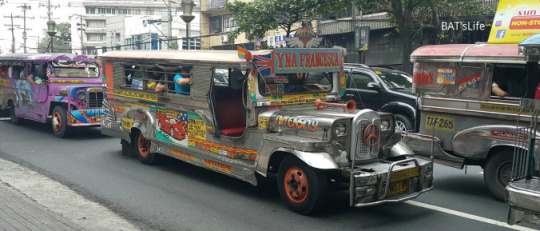
Classic Filipino Jeepney
Manila sprawls at the centre of the Philippines’ largest island.
A touch smaller than Cuba, Luzon could easily eat up the visa-free allowance that many passport holders are given upon entering the country.
After the smog, heat and bustle of Manila, it’s bliss to ascend into the cooler Cordillera, a pine-forested chain of mountains sheltering laid-back towns like Sagada, a faintly mystical, hippy hideaway, and Baguio, a hill station established by the American military, who forced Spain out of the Philippines in 1898.
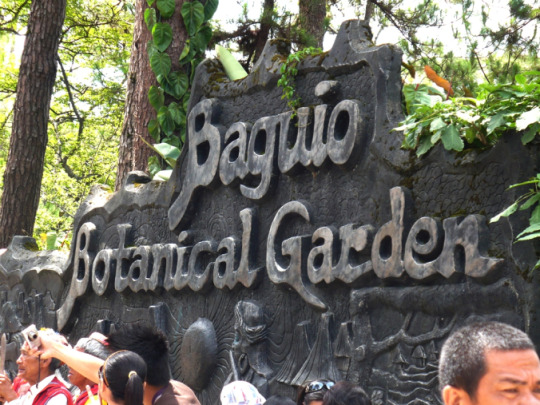
Baguio Botanical Gardens
The Cordillera hides waterfalls, sacred caves with entombed mummies and museums that depict the customs of ancient headhunters.
But the main pull is the UNESCO World Heritage-listed rice terraces skirting the small towns of Banaue and Batad.
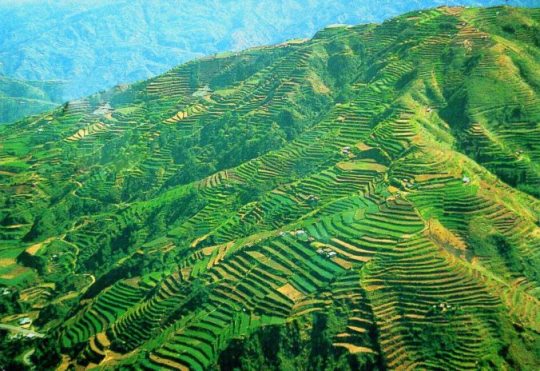
Banaue Rice Terraces
Dating back to the days before Christ, these magnificent amphitheatres — hewn with hand, mud and stone by the Ifugao people (one of several tribes still living in the region) — are edged by invigorating hiking trails. Travellers can do bamboo and nipa hut home-stays in Batad, where the worst of the noise pollution comes from crowing roosters and playful children.
A little sister gets a lift
Further north, the Philippines’ best-preserved Spanish town, Vigan, has cobblestone streets, Mediterranean mansions, sturdy Catholic churches that were built to withstand earthquakes; one form of disastrous natural phenomena that the Philippines is vulnerable to and vibrant festivals like January’s Vigan Town Fiesta – it’s a blaze of colour, music and processions.
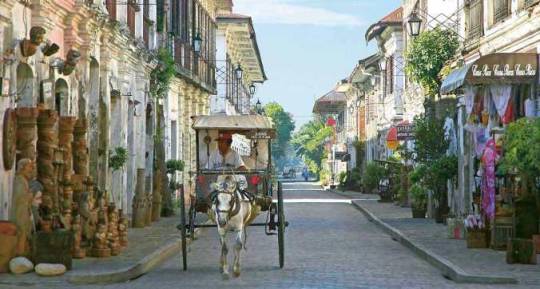
Horse-drawn carriage in Vigan
You can tour Vigan in a calesa, a two-wheeled horse carriage that is just one of the country’s eye-catching (and often hair-raising) modes of transport. Most prevalent is the jeepney. A Philippines classic, the ex-US Army jeeps-cum-minibuses daubed in technicolour graffiti spawning messages of love, politics and religion. Similar designs cover tricycles, the Filipino rickshaws that are basically motorbikes with bolted-on sidecars.

Swimming with the Butanding
In South Luzon, you can swim with giant butanding (whale sharks) off the coast of Donsol, and see smoking Mount Mayon (a perfect cone volcano blooming from rice fields). Volcanoes loom either side of Manila. Day-trippers scale Mount Pinatubo, which last erupted in 1991, and Taal, which emerges, rather magically, out of a lake.
Left: Taal, Right: Mt. Pinatubo(top) Mt. Mayon(bottom)
BORACAY BLISS
Choosing the Philippines’ most beautiful beach is nigh-on impossible; there are so many. The most hyped is Boracay Island’s White Beach, a luscious, four-kilometre lick of powdery sand, edged by giant, lurching coconut palms and stroked by gentle azure waters crawling with paraws (traditional sailing boats).
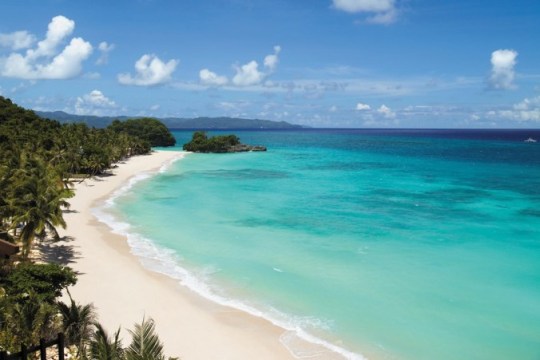
Boracay's white sand beaches
Though Boracay is paradise to many Filipinos (and Americans, South Koreans, Taiwanese and Chinese, who comprise the bulk of the international tourists), some complain that it’s become too developed.
Compared to Thailand’s Patong and Bali’s Kuta, however, Boracay is still pretty laidback. And as you enjoy a seafood platter — grilled squid, octopus, shrimps and snapper – with a chilled San Miguel beer, while watching the sun melt into the sea, sending the sky into a frenzy of pinks and oranges, White Beach doesn’t seem such a bad place to linger.
SEE CEBU
Less frenetic than Manila, Cebu is the Philippines’ second major gateway. Its international airport is on Mactan Island, where Iberian explorer Ferdinand Magellan met his end at the hands of tribal leader Lapu-Lapu in 1521.
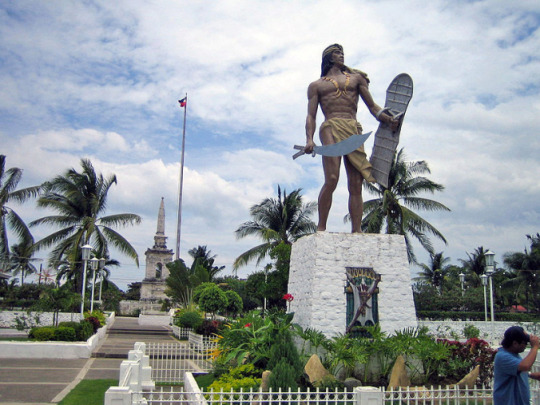
Magellan Shrine (back), Lapu-Lapu Shrine (front)
A 20-minute taxi ride away, Cebu City boasts the country’s oldest street and church, a ruined Spanish fort, and renowned eateries, like Zubuchon, where globetrotting celebrity chef Anthony Bourdain feasted on lechon (spit-roasted suckling pig). His verdict? “Best pig ever!”
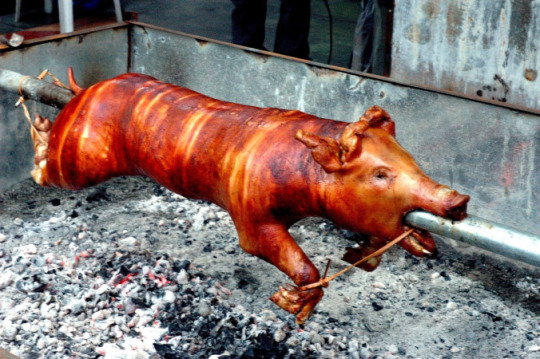
Pinoy lechon, roasting over hot coals
While not as famous as Thai or Vietnamese food, Filipino cuisine is extremely varied and flavoursome.
Touted as the national dish, adobo is a vinegary, garlicky dish that comes in beef, pork and chicken variations, with rice. It’s served everywhere, from upscale bistros to boisterous street markets where families and friends munch and socialise around plastic tables and chairs.
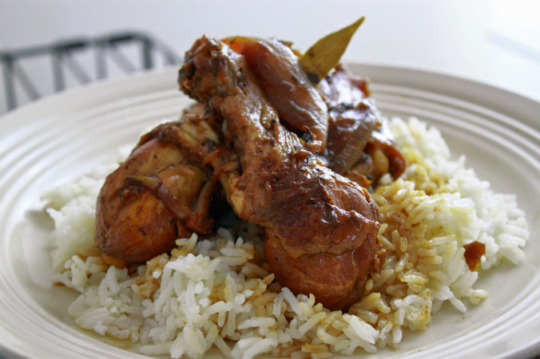
Adobong Manok chaka kanin
Balut (half-developed duck embryo) is among the more offbeat culinary options. A favourite Filipino dessert is halo-halo, a revitalising concoction of milky crushed ice, fresh fruit (like mango, banana and papaya) and ice-cream.
Balut (left), Halo-Halo (right)
I could go on and on about the delights of Filipino cuisine, but I think I’ll leave that for another time…
The hub of the Visayan archipelago, Cebu is the launchpad for ferries and catamarans to myriad tempting islands, best explored on a motorbike or bicycle. Gems include Siquijor which is famed for its witches and shamans and the bucolic Bohol, which is on the road to recovery after suffering back-to-back jolts in late 2013. A devastating 7.2 earthquake was followed three weeks later by Typhoon Haiyan (or Yolanda, as it was known in the Philippines).
Although some of Bohol’s centuries-old churches were reduced to rubble, its iconic, tubby Chocolate Hills are still largely intact.

Chocolate Hills, Bohol
These 100-metre high mounds turn brown in the dry season between March and May (but are a luxuriant green for most of the year).
Another Bohol highlight is the tarsier. You can glimpse these cute, wide-eyed creatures — some of the planet’s tiniest primates — in the trees of Bohol’s Philippine Tarsier Sanctuary.

Bohol Tarsiers
BEST OF THE REST
Like Borneo, Palawan conjures up a sense of the far-flung and unexplored. Its languid provincial capital, Puerto Princesa, is just an hour’s flight from Manila, but oozes Eden-esque qualities.
One of the few pockets of civilisation, El Nido is a traveller-friendly town surrounded by hulking limestone cliffs, pristine beaches and sparkling emerald lagoons. Hop in a bangka (an outrigger vessel) or kayak and imbibe scenery that resembles Phi Phi in Thailand, only with a fraction of the tourists. North of Palawan, the Calamian Islands are believed to have inspired Alex Garland to write The Beach.
Strolling along the beach in El Nido, Palawan
Calamian includes the hallowed wreck-dive spot of Coron, where more than a dozen Japanese ships were sunk during World War II. Coral-rich reefs teeming with tropical fish, turtles, sharks and dugongs, pepper Filipino waters, with world-class dive sites off Panglao Island, south of Bohol, Apo Island, off Negros, and Puerto Galera, Mindoro.
In the Philippines’ deep south, hardcore surfers tackle the “Cloud Nine” break off Siargao Island, while adventure-seekers are drawn to Camiguin, a pear-shaped island with seven volcanoes. Both are near Mindanao, the country’s second largest island.
Currently, Mindanao is out-of-bounds to tourists due to a proclamation of Martial Law by Philippine President Rodrigo “Digong” Duterte, initiated to counter the pro-ISIS Maute terrorist group, who recently took a hold in Marawi City. Troops are currently active in the region, although the rest of the country is as safe as ever.
MORE INFORMATION
It’s More Fun In The Philippines
Department of Tourism, Philippines
TEN ESSENTIAL PHILIPPINES EXPERIENCES
Sip Tanduay rum and coke, a San Miguel or a fresh fruit juice while soaking up a Boracay sunset.
Filipinos are rarely more gleeful than during karaoke sessions. Go on, join in.
3. Hike through and marvel at the ancient rice terraces lording over Banaue and Batad.
Rub shoulders with a cocktail of humanity in a jeepney.
Ogle awe-inspiring wildlife, whether it be tarsiers on land or butanding under water.
Indulge your inner mall rat and relax the purse strings in Manila’s glut of shopping centres.
Navigate turquoise Filipino seas in a ferry, kayak or bangka (outrigger boat).
Enjoy a taste of the local street foods, including barbecued isaw, kwek-kwek, and fish balls.
You’ll be offered hundreds of massages on your Filipino holiday. Accept one (at least).
Stumble across your own empty, postcard-perfect tropical beach.
Fish balls, squid balls, kwek-kwek, and kikiam, favoured street foods of Filipinos
Secret’s out: Asia’s most overlooked paradise The Philippines is often overlooked by foreign travellers in favour of other Asian destinations, but there's no better time to get to know this tropical archipelago.
0 notes